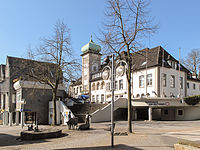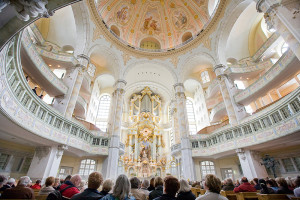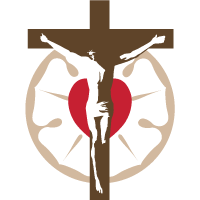by Rev. Stephen Preus
 If you are a Lutheran, chances are that the music of Philipp Nicolai has delighted your ears and his words have flowed joyfully from your tongue.[1] Nicolai is the writer of text and tune of what have become known as the “Queen of Chorales” (“O Morning Star, How Fair and Bright”)[2] and the “King of Chorales” (“Wake, Awake, for Night is Flying”).[3] The marriage of biblically pure and comforting theology with musical reverence and beauty without a doubt provide little argument regarding the accuracy of these royal designations. For such works of pious hymnody we have Nicolai to thank. But there is more to Philipp Nicolai than his two famous hymns.[4]
If you are a Lutheran, chances are that the music of Philipp Nicolai has delighted your ears and his words have flowed joyfully from your tongue.[1] Nicolai is the writer of text and tune of what have become known as the “Queen of Chorales” (“O Morning Star, How Fair and Bright”)[2] and the “King of Chorales” (“Wake, Awake, for Night is Flying”).[3] The marriage of biblically pure and comforting theology with musical reverence and beauty without a doubt provide little argument regarding the accuracy of these royal designations. For such works of pious hymnody we have Nicolai to thank. But there is more to Philipp Nicolai than his two famous hymns.[4]
The third of eight children, Nicolai was born August 10, 1556 at Mengeringhausen in Waldeck (Hessen, Germany). He was the son of a pastor, Dietrich Rafflenbeul,[5] who had in adulthood taken himself and a part of the congregation he served in Herdecke into the Church of the Augsburg Confession. Nicolai’s childhood revealed in him an outstanding intellect. While his father initially taught him, due to the plague in Mengeringhausen in 1567 Nicolai and his brothers were sent to many schools for the next several years. As a teenager Nicolai’s predilection for poetry and interest in theology became evident, proclivities which continued into his university education in Erfurt in 1575. Due to the death of his brother Jonah and his mother and a needed return home, his time in Erfurt was brief. When he resumed his education, he did so at the University of Wittenberg, completing his formal study in theology in 1579.
 Nicolai was ordained into the ministry in 1583 and called to Herdecke, where his father had served. He was pastor there for three years, during which time he faced a hostile Roman Catholic town council and the outbreak of the Cologne War. Nicolai left his post in 1586 and by 1587 found himself pastor at the parish in Nieder-Wildungen in his home county of Waldeck. He was moved within the city to Alt-Wildungen the next year at the word of widowed Countess Margaret of Waldeck and became her court preacher, father confessor, and the tutor of her son, Count Wilhelm Ernst, who became the inspiration for “Wake, Awake” after his untimely death at the hands of the bubonic plague in 1598.
Nicolai was ordained into the ministry in 1583 and called to Herdecke, where his father had served. He was pastor there for three years, during which time he faced a hostile Roman Catholic town council and the outbreak of the Cologne War. Nicolai left his post in 1586 and by 1587 found himself pastor at the parish in Nieder-Wildungen in his home county of Waldeck. He was moved within the city to Alt-Wildungen the next year at the word of widowed Countess Margaret of Waldeck and became her court preacher, father confessor, and the tutor of her son, Count Wilhelm Ernst, who became the inspiration for “Wake, Awake” after his untimely death at the hands of the bubonic plague in 1598.
Controversy with the Calvinists and polemical works against them marked much of Nicolai’s life.[6] During his time at Alt-Wildungen he was even briefly banned from preaching and refused his doctorate from the University of Marburg for his harsh words against the Reformed teaching on Christ and the Lord’s Supper. Shortly after, however, he did receive his doctorate from the University of Wittenberg.
 In 1596 Nicolai became pastor at St. Catharine’s Church at Unna, something the Calvinists tried (and failed) to prevent. These were hard days for Nicolai. Two sisters died, and from mid 1597 to early 1598 the plague hit, death taking more than 1,300 of Unna’s inhabitants. One can picture with dolefulness Nicolai looking out from his parsonage at the fresh graves dug in seeming perpetuity in the churchyard; on one particular day they dug thirty graves. The crisis brought out the pastor in Nicolai.[7] He immersed himself in caring for his congregation, praying for them, and focusing them on the eternal life that is theirs in Christ. Also from this came a work of Nicolai’s that was “fragrant with the pure aroma of heavenly flowers.”[8] This work was titled “A Mirror of the Joys of Everlasting Life”[9] and was dedicated to his congregation and the people of Unna.
In 1596 Nicolai became pastor at St. Catharine’s Church at Unna, something the Calvinists tried (and failed) to prevent. These were hard days for Nicolai. Two sisters died, and from mid 1597 to early 1598 the plague hit, death taking more than 1,300 of Unna’s inhabitants. One can picture with dolefulness Nicolai looking out from his parsonage at the fresh graves dug in seeming perpetuity in the churchyard; on one particular day they dug thirty graves. The crisis brought out the pastor in Nicolai.[7] He immersed himself in caring for his congregation, praying for them, and focusing them on the eternal life that is theirs in Christ. Also from this came a work of Nicolai’s that was “fragrant with the pure aroma of heavenly flowers.”[8] This work was titled “A Mirror of the Joys of Everlasting Life”[9] and was dedicated to his congregation and the people of Unna.
Nicolai was forced to leave Unna at the end of 1598 due to impending war with the Spaniards, returning months later in April of 1599. In 1600, at the age of 44, Nicolai was married to Catharine von der Recke, a widow with two children. In 1601 he received a call to serve St. Catharine’s Church in Hamburg. Here he gained his reputation as a preacher. He was even labeled the “second Chrysostom,” after the golden-tongued church father. Beloved by his colleagues and congregation, Nicolai was offered three professorships during his time at Hamburg but turned each of them down. During this time he also wrote a two volume work “On God’s Mystical Temple,” which is his contribution to systematic theology.
Nicolai remained in Hamburg the rest of his life. After participating in the ordination of a friend on October 22, 1608, he fell ill. He died October 26, 1608 and was buried in St. Catharine’s Church.
 While much more could be written about Nicolai’s life and career, [10] for the sake of brevity we end here. His despisers disparaged him. His admirers adored him.[11] A pastor, a poet, a polemicist, a steadfast Lutheran confessor and theologian, we give thanks to our Lord for him as we stay awake, waiting with him and all the saints in heaven and on earth for our Morning Star, our heavenly Bridegroom, our Lord Jesus Christ to bring the consummation of the endless ages at the day of the resurrection of all the dead.
While much more could be written about Nicolai’s life and career, [10] for the sake of brevity we end here. His despisers disparaged him. His admirers adored him.[11] A pastor, a poet, a polemicist, a steadfast Lutheran confessor and theologian, we give thanks to our Lord for him as we stay awake, waiting with him and all the saints in heaven and on earth for our Morning Star, our heavenly Bridegroom, our Lord Jesus Christ to bring the consummation of the endless ages at the day of the resurrection of all the dead.
The Rev. Stephen K. Preus is pastor of Trinity Lutheran Church, Vinton, Iowa.
[1] Even if you are not a Lutheran, Nicolai’s hymns have found their way into many hymnals of other confessions. They portray biblically and clearly the hope of the Christian Church for the return of our Lord.
[2] Lutheran Service Book, 395. This hymn has become the traditional Lutheran Hymn of the Day for the Second Sunday after Epiphany. For another translation see The Lutheran Hymnal 343.
[3] Lutheran Service Book 516. This hymn has become the traditional Lutheran Hymn of the Day for The Last Sunday of the Church Year.
[4] Interestingly, Nicholai only wrote four hymns total, one of which with quite the polemical title: “A Complaint of the Christian Church to God About the Calvinists and the Sectarian Spirits.”
[5] The name “Nicholai means “the son of Nicholas,” which is what Dietrich called himself. This name was taken as the surname by Dietrich’s children, including Phillip.
[6] While these controversies and the polemical works of Nicolai are a major part of his life, I have not included them in the body of this text for the sake of brevity. For a more thorough understanding of his polemical works see Authur Carl Piepkorn’s article “Philip Nicolai” in Concordia Theological Monthly, Vol. XXXIX, July-August 1968. You can access it at media.ctsfw.edu.
[7] Piepkorn, 439.
[8] Quoted in Piepkorn, 439.
[9] See the article on Philipp Nicolai in CPH’s newly published Lives and Writings of the Great Fathers of the Lutheran Church (pp. 37 ff.) for an excerpt from this work.
[10] Again, for a more thorough treatment of Nicolai and his theology see Piepkorn, who discusses him as “The Preacher,” “The Hymn Writer,” “The Mystic,” “The Hymn-Tune Composer,” “The Polemicist,” “The Missiologist,” “The Theologian,” and also “Nicolai’s Credo,” 448-460.
[11] This is no exaggeration: “During Philipp Nicolai’s lifetime the company of ministers in the city of Zurich referred to him as ‘this miserable person who goes thrashing around and biting like another wild boar, altogether without reason or Christian modesty.’ Others of his foes called him a lunatic who ought to be chained to a wall, and could not resist the temptation of twisting his surname Nicolai into ‘Nicolaitan’ [see Rev. 2:6]. His admirers, on the other hand, saw in him ‘a second Chrysostom.’” Piepkorn, 432.
